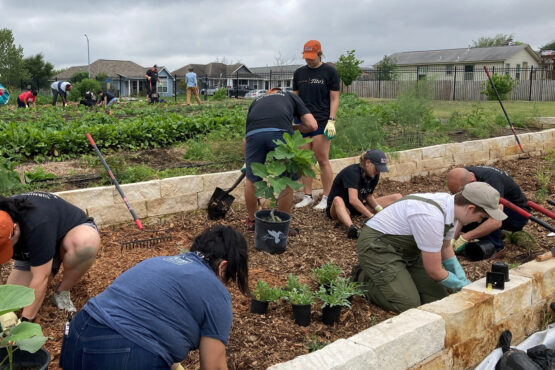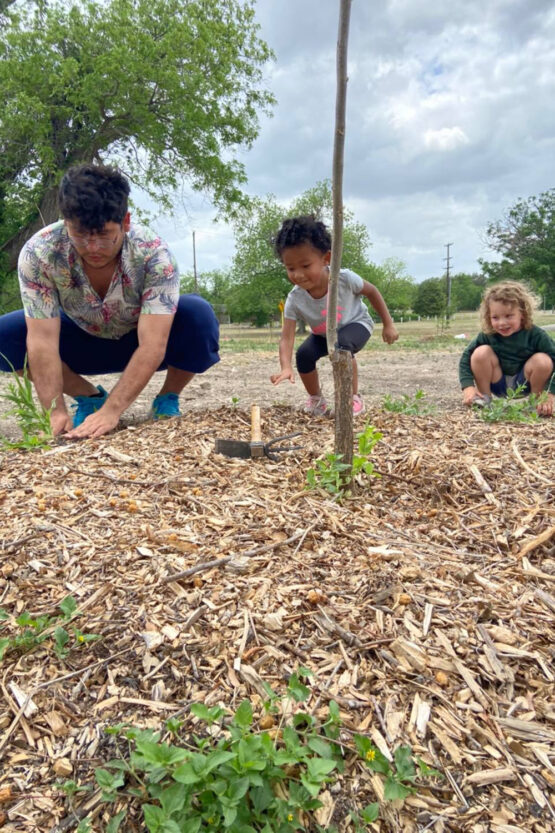Food forests and urban farms hold promise of addressing numerous problems at once
Stanford’s Natural Capital Project to present a new report to the San Antonio city council on May 25 about ways to strategically and equitably scale-up urban agriculture.
What if you could grow fresh food where it is most needed, cost-effectively reduce heat-related deaths, and create green space for the local community? What if you could also reduce flooding and help mitigate climate change? These questions and more are at the heart of a report on the many possibilities of urban agriculture that the Stanford-based Natural Capital Project (NatCap) is presenting this week to a San Antonio City Council subcommittee.
Go to the web site to view the video.
The report considered two forms of urban agriculture: food forests and urban farms. Food forests are a system of perennial crops – primarily fruit and nuts – planted in layers to mimic a mature ecosystem with plants of differing heights. They are intended to provide food, shade, a haven for pollinators and other wildlife, and to capture water in the landscape. Urban farms typically grow and sell annual mixed vegetable crops, while food forests are primarily perennial orchard crops and tend to be open-access public spaces where people can pick food for free.
A collaboration between NatCap, the Food Policy Council of San Antonio, and three San Antonio city departments (Innovation, Metro Health, and Sustainability), the report estimates the amount of food that could be produced by urban farms and food forests, as well as some of their additional benefits: urban cooling, carbon storage, flood retention, and green space. Anne Guerry, chief strategy officer and lead scientist at NatCap, explained, “Using our model, we took all the publicly owned natural areas in San Antonio and reimagined them from vacant or underutilized lots to farms and food forests. Then, we calculated the benefits that would be provided.”
Specifically, the team found that if all underutilized, publicly owned land in San Antonio were converted to food forests – as an upper limit on what’s possible – they could provide 192+ million pounds of food a year, worth $995 million and enough to feed nearly 314,000 households for a year. Food forests would also provide $3.5 million in urban cooling services per year (potentially saving ~600 lives per year), reduce flooding, increase carbon sequestration, and significantly increase access to green space. If all underutilized publicly owned land in San Antonio were converted to urban farms, they could provide 926 million pounds of food worth $1.17 billion, enough to feed 1.27 million households. Without careful management, farms might increase nutrient pollution to neighboring areas from compost runoff – which has negative effects on water quality and aquatic life – and potentially reduce green space access, though less so than many alternative development scenarios like buildings or parking lots.
Using San Antonio as the pilot and with funding from NASA’s Environmental Equity and Justice program, NatCap is developing an online tool that will allow urban planners without technical expertise to use NatCap’s InVEST models to explore how different development scenarios change the distribution of nature’s benefits to different groups of people.
Improving equity by linking supply and demand for food
Residents of low-income neighborhoods in San Antonio face a wide range of issues, including a greater risk of health problems such as obesity, diabetes, and heart disease stemming from a lack of access to healthy foods. These neighborhoods can also be up to 20 degrees Fahrenheit hotter than surrounding areas, and two of the local counties have the highest risk from flash flooding in the state of Texas. The city of San Antonio has recognized that urban agriculture can offer some relief from all of these challenges and aims to expand it, including through this report’s findings.

Volunteers plant crops at Garcia Street Urban Farm, in San Antonio, Texas. (Image credit: Garcia Street Urban Farm)
“In a lot of places in America, urban and rural, people have to travel a long distance to reach supermarkets, to be able to access both food in general and also healthy food,” said Jess Silver, ecosystem services analyst with NatCap. “Part of the goal of this analysis was to really try and understand some of those food-related inequities across the city … to think about the potential production of urban agriculture and also the needs of the communities located around urban farms or urban food forests.”
Thus, the report focuses on urban agriculture in locations where fresh food is less accessible. Using information from the U.S. Census on use of Supplemental Nutrition Assistance Program (SNAP), or food stamps, the models identified several districts where the demand for local food production is highest – and thus may be good places to target investments in urban agriculture for the greatest impact. These districts also suffer disproportionately from heat, so food forests can offer significant cooling benefits as well.
Expanding on local successes
Mitch Hagney, who runs his own local produce business in San Antonio and is on the board of the Food Policy Council of San Antonio, has played a pivotal role in establishing the first food forest in the city, the Tamōx Talōm Community Food Forest (a partnership between the Food Policy Council of San Antonio, the city’s Office of Innovation, and Bexar County’s Parks and Recreation Department). Hagney has worked closely with the NatCap team throughout the past year.
“Our hope is the results from this report are able to galvanize action to expand urban agriculture in San Antonio; helping policymakers do things like increase tool access for would-be farmers or food foresters, use vacant lots as potential long leases for urban farms, and include food forests in land management practices for our parks department and public works department,” said Hagney. “Hopefully, examples of how urban agriculture can flourish in this city can be applicable all throughout the rest of the United States, so every city can have environmentally-friendly and equitable urban agriculture plans.”
The report recommends that San Antonio aim for a mix of urban farms and food forests, carefully consider where to locate them in order to support neighborhoods with greater food insecurity, and address potential downsides of urban farms by offering alternative public green space and reducing nutrient runoff by limiting compost use. The NatCap team hopes to continue working with San Antonio to further support their expansion of urban farms and food forests. More information about NatCap’s urban-focused projects can be found here.

